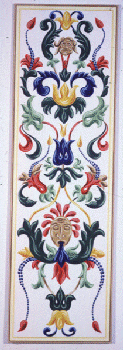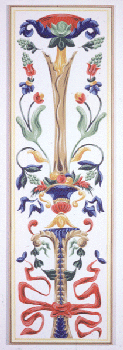 Elizabeth Pulie, Tall Work, 1996 |
Tall Work
|
 Elizabeth Pulie, Tall Work, 1996 |
 Elizabeth Pulie, Tall Work, 1996 |
Tall Work
|
 Elizabeth Pulie, Tall Work, 1996 |
|
Elizabeth Pulie, Tall Work, 1996 |
The power to construct and redistribute relationships
between objects, images, texts and their environments is
commonly attributed to digital technologies. Electronic
contexts have been used to generate a continuous
reassembly and re-presentation of historical images and
sounds. Synthesis, distortion, malfunction and speed
characterise the media saturated environment of the late
twentieth century; modes of imaging and ways of thinking
accepted and utilised by generations who grew up amidst
remote controls, multi-channels, digital toys and modems.
What place is there amongst the bitmaps and bytes for an artist working in the time honoured tradition of painting? Akin to much imagery produced on computer software, Elizabeth Pulie's latest exhibition of painted canvases, Tall Work, reflects a decorative aesthetic. However, Pulie's incorporation of ornament, with its attendant history, represents a deliberate and provocative strategy that differentiates it from much digital imagery. In previous exhibitions at Sutton Gallery, Pulie's paintings have referenced folk and popular art, William Morris' Arts and Crafts designs and Elizabethan period patterning, deferring the scission dividing the legacies of culture and heritage, interior design and architecture, artisan and artist. Her egalitarianism, artistic not moralistic, is a levelling tactic. An extension of these ideas, Tall Work has an added sense of the rococo in its novelty - a light-hearted flouting of contemporary and historical artistic mores and an imaginative relationship to notions of the "natural". |
|
Elizabeth Pulie, Tall Work, 1996 |
Derivation and deviation from the forms of nature
within the design process has been the subject of
treatises and encyclopedic references for hundreds of
years. An oeuvre that is acknowledged by numbered
canvases instead of titles, Pulie's collected works would
trouble turn-of-the-century grammarians of design in her
variation from natural models and innovation on selected
prototypes. Blending Pompeian and Italianate references
in the arabesques of each painting (motifs that were
reinterpreted in late eighteenth century English
architecture and design), Tall Work reflects on
the undermining of historical knowledge and the processes
of forgetting. In The Sense of Order: A Study in the Psychology of Decorative Art (1979), E. H. Gombrich pedantically relates the word "design" to technology in its wider sense of "giving form", whereas "ornament" is considered as conveying the notion of a knick-knack on the mantle-piece, "pattern" a model and "design adornment". Art and technology operate within the same commodity culture, continually reinforcing and reacting to the desire for faster, more user friendly modes. Mixing genres in a synthesis of popular and high art, Pulie slows down the viewing experience of painting. Her work is a site where associations are accumulated rather than scanned, a recognition of the historical absorption of art forms into everyday cultures from unacknowledged sources of inspiration. The trompe l'oeil of Tall Work is flawless but never seamless, the artist's method pertaining to the abstract processes of sampling from and fusing source materials necessary in the development of form, practices and ideas. The highly coloured arabesques, fruits, flora and fillets of Tall Work do not aspire to sentimentality and are without the nostalgia often accompanying mimetic or simulated forms. The panels recall interconnections between technologies of design, art and fashion and their associated social climates, or notions of taste and popularism of styles with their capricious relations to ethical and moral justifications. The elements of Tall Work capture some of the eclectic qualities of a post- industrial sensibility; hybrid, distorted, ambiguous, reiterative, perverse, accommodating, abusive and vestigial. As with all Pulie's painting, Tall Work is synthetic, in this instance confusing the boundaries between the natural and artificial, the organic and inorganic whilst playfully subverting both artistic and technological determinism. Zara Stanhope |